
Edfu was one of several temples built during the Ptolemaic period, including Dendera, Esna, Kom Ombo and Philae. Its size reflects the relative prosperity of the time and it remains one of the best preserved temples. The present temple, which was begun in 237 BCE, initially consisted of a pillared hall, two transverse halls, and a barque sanctuary surrounded by chapels built on the west side of the Nile. The building was started during the reign of Ptolemy III and completed in 57 BC under Ptolemy XII. It was built on the site of an earlier, smaller temple also dedicated to Horus, although the previous structure was oriented east-west rather than north-south as in the present site. A ruined pylon lies just to the east of the current temple; inscriptional evidence has been found indicating a building program under the New Kingdom rulers Ramesses I, Seti I and Ramesses II. We can also clearly see the mast grooves for the flags which would have fluttered at the entrance. The site of Edfu Tell was known as Wetjeset-hor (classical name Apollinopolis Magna), the place where the god Horus was worshipped and where the battle between Horus and his traditional enemy Seth in ancient mythology took place. Of all the temple remains in Egypt, the Temple of Horus at Edfu is the most completely preserved. Built from sandstone blocks, the huge Ptolemaic temple was constructed over the site of a smaller New Kingdom temple, oriented east to west, facing towards the river.

The temple of Edfu fell into disuse as a religious monument following Theodosius I’s edict banning non-Christian worship within the Roman Empire in 391 CE. As elsewhere, many of the temple’s carved reliefs were razed by followers of the Christian faith which came to dominate Egypt. Over the centuries, the temple became buried to a depth of 12 metres (39 ft) beneath drifting desert sand and layers of river silt deposited by the Nile. Local inhabitants built homes directly over the former temple grounds. Only the upper reaches of the temple pylons were visible by 1798, when the temple was identified by a French expedition. In 1860 Auguste Mariette, a French Egyptologist, began the work of freeing Edfu temple from the sands. Little more than the temple has been freed from the sands, it is probable that many more archeological finds exist under the city of Edfu.
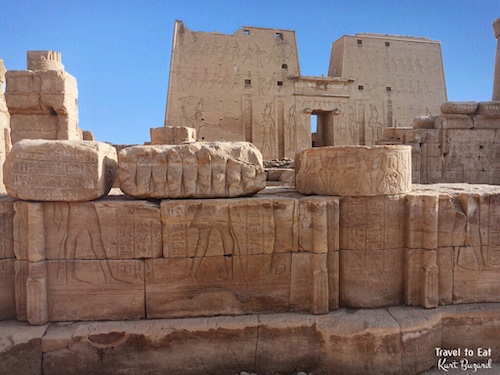
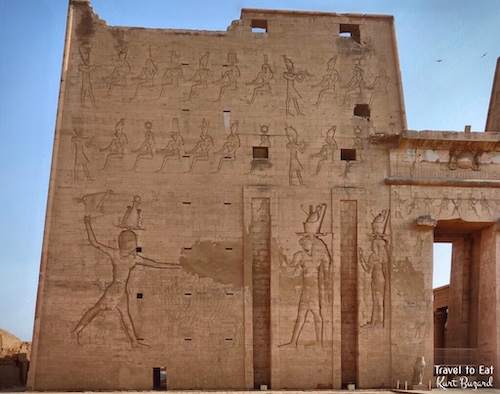

The entrance pylons were erected by Ptolemy IX (116-107 BCE) before he was ousted from power by his brother Alexander (Ptolemy X Alexander I 107-88 BCE), who was later usurped by Ptolemy IX Soter II (88-80 BCE). The first pylon at Edfu Temple was decorated by Ptolemy XII Neos Dionysos (117-51 BCE) in 57 BCE with figures of himself smiting the enemy. The entrance pylons and the peristyle court were added, and finally completed in the reign of Ptolemy XII, the father of the last Cleopatra (Cleopatra VII 51-30 BC). His reign as king was interrupted by a general rebellion that resulted in his exile from 58 to 55 BC. Thus, Ptolemy XII ruled Egypt from 80 to 58 BC and from 55 BC until his death in 51 BC. Note that the cartouche on the left pylon (from 58 BCE) is slightly different from the right pylon. Ptolemy XII was generally described as a weak, self-indulgent man, a drunkard, and a music lover. Unusually, the twin towers of the great entrance pylon of the temple were planned as perfect mirror images of each other, both in their construction and in the rather curiously rendered scenes carved on their surfaces. Two statues of Horus as a falcon flank the entrance gate, and behind the pylon, at the base of the walls on either side of the entrance, are scenes depicting the “Feast of the Beautiful Meeting” in which Horus of Edfu was united with Hathor of Dendera.



At Edfu, Horus was worshipped as the falcon Horus of Behdet. The Temple was called Mesen, The Place of the Harpoon, the Mansion of Ra, Nedjem-Ankh, Pleasant to Live In, the Window of the Falcon, the Shrine of Horus, and Wetjeset, the Place of Extolling the God.
Court of Offerings




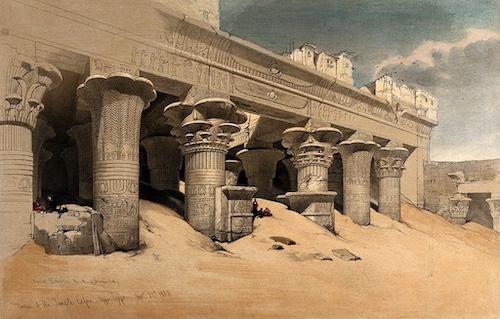


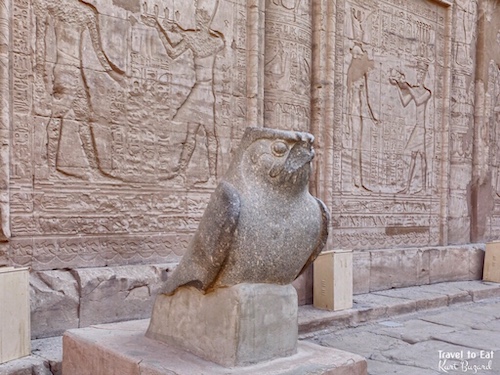

Beyond the Pylon is the spacious “Court of Offerings”, where people could enter to make offerings to the image of Horus. The court is surrounded by columns on three sides and is decorated with festival reliefs. Beginning on the inner walls of the Pylon and continuing around the court along the bottom of the wall, the reliefs depict the Festival of the Beautiful Meeting, during which Hathor’s image sailed from Dendera to spend some intimate time with Horus in the sanctuary of the Temple of Edfu before sailing back. Beneath the western colonnade are reliefs of Ptolemy IX (88-81 BC) making offerings to Horus, Hathor and Ihy; his successor is shown with the same deities across the way. The panels at the back of the forecourt are decorated with Ptolemy VI Philometer.
Hypostyle Halls





The rectangular Hypostyle Hall was built under Ptolemy VII (145-116 BC) and has two rows of six pillars supporting an intact roof. The ceiling has astronomical paintings symbolizing the sky. Unfortunately, at some ancient time, fires were built in the hypostyle and pronaos halls obscuring the painting with soot. Some say the blackened ceiling of the hypostyle hall, visible today, is believed to be the result of arson intended to destroy religious imagery that was then considered pagan.
Nilometer

Beyond the great hypostyle hall is a second, smaller hypostyle hall which leads to a well called the Chamber of the Nile where the Priests obtained pure holy water. This is a similar arrangement as found at Dendera. On the west side of the room are doors that lead to a small laboratory with recipes engraved on the walls for ointments and perfumes which where used daily to anoint the statue of Horus, and to a treasure room where offerings were stored.
Ptolemy Cartouches


For convenience, I have included the Ptolemaic cartouches of Ptolemy III through Ptolemy X. I could not find a cartouche for Ptolemy VII Neos Philopator. It is said the cartouche is the same as Ptolemy VI Philometer with the addition of a scarab. His reign is controversial, and it is possible that he did not reign at all, but was only granted royal dignity posthumously. Ptolemaic cartouches are a treacherous territory and I have included two lists in an attempt to be complete. Some of the depictions are contradictory, such is the state of current Egyptololgy.
Ptolemy IV Philopater




Ptolemy IV Philopator, son of Ptolemy III and Berenice II of Egypt, was the fourth Pharaoh of Ptolemaic Egypt. The decline of the Ptolemaic dynasty began under the reign of Ptolemy IV. Ptolemy IV’s reign was inaugurated by the murder of his mother, and he was always under the dominion of favorites, male and female, who indulged his vices and conducted the government as they pleased. The one positive of his reign was the campaign against Antiochus III the Great on Coele-Syria including Judea, and Ptolemy himself was present at the great Egyptian victory of Raphia (217 BC) which secured the northern borders of the kingdom for the remainder of his reign. The arming of Egyptians in this campaign had a disturbing effect upon the native population of Egypt, leading to the secession of Upper Egypt under pharaohs Harmachis (also known as Hugronaphor) and Ankmachis (also known as Chaonnophris), thus creating a kingdom that occupied much of the country and lasted nearly twenty years. A quick note, the cartouche of Ptolemy III and Ptolemy IV are often difficult to differentiate.
Babi the Baboon God

Babi, also Baba, in ancient Egypt, was the deification of the baboon, one of the animals present in Egypt. His name is usually translated as “bull of the baboons”, and roughly means “alpha male of all baboons”, i.e. chief of the baboons. Since baboons exhibit many human characteristics, it was believed in early times, at least since the Predynastic Period, that they were deceased ancestors. In particular, the alpha males were identified as deceased rulers, referred to as the great white one (Hez-ur in Egyptian), since hamadryas baboon (the species prevalent in Egypt) alpha males have a notable light grey streak. For example, Narmer is depicted in some images as having transformed into a baboon.
Ptolemy IX Soter II and Ptolemy X Alexander I





These servers have the cartouche of Ptolemy X Alexander I above their heads. Ptolemy X Alexander I was King of Egypt from 110 BC to 109 BC and 107 BC till 88 BC. He was the son of Ptolemy VIII Physcon and Cleopatra III. In 110 BC he became King with his mother as co-regent, after his mother had deposed his brother Ptolemy IX Lathyros. However, in 109 BC he was deposed by Ptolemy IX. In 107 BC he became King again, and again with his mother as co-regent. In 101 BC he had his mother killed, and ruled either alone or with his niece/wife, Berenice III. When he died, Ptolemy IX regained the throne. When Ptolemy IX died, Ptolemy X’s wife Berenice III took over the throne for six months. The cartouche of Ptolemy IX and Ptolemy X are difficult to differentiate, I have relied on the analysis of Robert K. Ritner from the Oriental Institute of he University of Chicago to make the identification.
Ptolemy VIII


The main building was the great Temple of Horus Behedti. It was begun on August 23, 237 BCE, by Ptolemy III. In 206 BCE, during the rule of Ptolemy IV, work was halted by an insurrection during which two chiefs from the Theban area declared themselves independent of Ptolemaic rule. The temple was formally dedicated in 142 BCE by Ptolemy VIII Euergetes II and his wife Cleopatra II. Almost all the Ptolemies between these times had a hand in completing this temple. The defacement of temples was often blamed on the Christians who occupied the temples after the ancient Egyptians. In fact, there is some evidence that the defacing was done by ancient Egyptians living at the time although it is unlikely that they would deface the gods as well.
Ptolemy IV Philopator


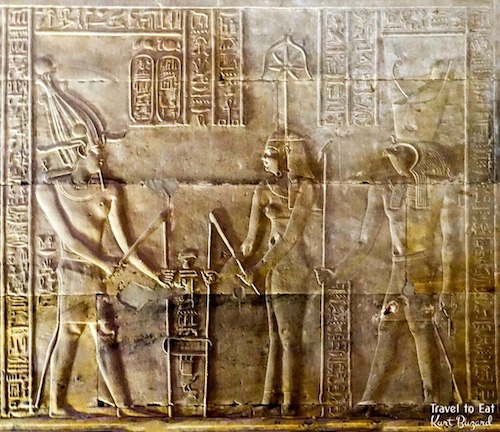

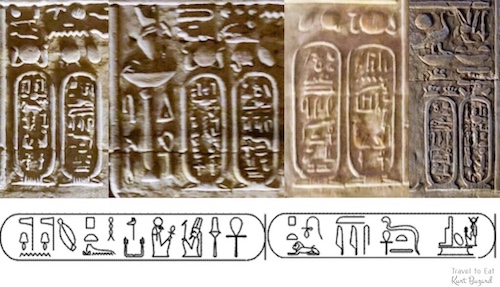

The corridor surrounding the sanctuary contains several interesting rooms worth exploring. For the most part they are dark areas, once illuminated by oil lamps (now with electric lights on the floor). It was built as an intentionally confusing area, I have chosen to present select tableaus on the walls. On the left (west) is the Linen Room, flanked by chapels to Min and the Throne of the Gods. In the back, a set of rooms nominally dedicated to Osiris has colorful reliefs of Horus receiving offerings (left room), a life-sized depiction of Horus’ barque (middle room) and reliefs of his avatars (rear room in the right/east wall).
Ptolemy V Epiphanes



Ptolemy V Epiphanes, who reigned 204–181 BCE, son of Ptolemy IV Philopator and Arsinoe III of Egypt, was the fifth ruler of the Ptolemaic dynasty. He inherited the throne at the age of five, and under a series of regents, the kingdom was paralyzed. The Rosetta Stone was produced during his reign as an adult. For almost his entire reign, Upper Egypt achieved total independence under a series of native pharaohs, which also had the effect of depriving the king of a substantial proportion of his revenues, besides necessitating an increased army of mercenaries to fend off the rebels. In an attempt to settle the civil problems, it was decided to crown the young prince as he turned twelve, at the old capital of Memphis in about 197 BC. This was the first time that a Ptolemy had been crowned in Memphis to our knowledge, but it did begin a tradition that would continue from then on. He took the Egyptian name, Iwaennetjerwy-merwyitu Setepptah Userkare Sekhem-ankhamun, the same as his father, which means “Heir of the [two] Beneficent Gods, Chosen of Ptah, Powerful is the Soul of Re, Living Image of Amun” Much of this is recorded in the decree of the priests of Memphis in 196 BC, and inscribed in three scripts (hieroglyphs, demotic and Greek) on the famous Rosetta Stone found in 1799.
Ptolemy VI Philometer


Ptolemy VI succeeded in 180 BC at the age of about 6 and ruled jointly with his mother, Cleopatra I, until her death in 176 BC, which is what ‘Philometor’, his epithet, implies; “he who loves his mother”. The following year he married his sister, Cleopatra II, as it was customary for Pharaohs, for the Ptolemaic Greek kings had adopted many customs of the Pharaohs. He had at least four children with her: Ptolemy Eupator, Ptolemy Neos, Cleopatra Thea and Cleopatra III, and possibly Berenice. I have mentioned this several times before but the re-interpretation of the two ladies of Egypt, Wadjet and Nekhbet, into two salacious nude women crowning him is a Ptolemaic invention.
Hapi, God of the Nile Flood

I have previously written on Hapi, the God of the annual Nile inundation during the reign of Rameses II. This figure shows that the cult of Hapi was alive and well despite appropriations of powers by Sobek, the crocodile God, during the Ptolemaic period (particularly at Kom Ombu). The flood deposited rich silt (fertile soil) on the river’s banks, allowing the Egyptians to grow crops. Hapi was greatly celebrated among the Egyptians. Some of the titles of Hapi were, Lord of the Fish and Birds of the Marshes and Lord of the River Bringing Vegetation. Hapi is typically depicted as an intersex person with a large belly and pendulous breasts, wearing a loincloth and ceremonial false beard.
Sanctuary of Horus




This is the Sanctuary of Horus, the holiest part of the temple at the rear of the temple. The sanctuary centers on a black-granite shrine that was dedicated by Nectanebo II, making it the oldest relic in the temple. This once contained the gilded wooden cult image of Horus. Next to the shrine is an offering table and the ceremonial barque (barge) on which Horus was carried during festivals. Reliefs on the right (east) wall of the sanctuary show Philopator (Ptolemy IV) worshipping Horus, Hathor and his deified parents in the sanctuary. The ceiling was once painted with the night sky. There are reliefs of the ceremonial barque feign carried in the rooms and corridors surrounding the sanctuary.
Mammisi or Berthing House

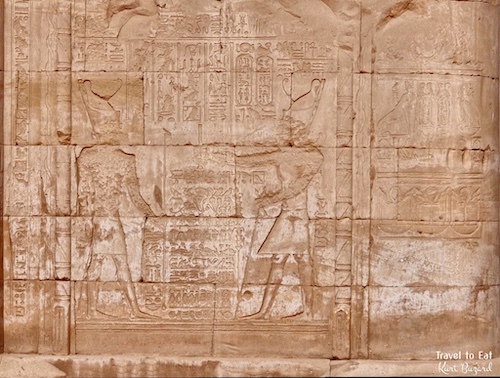

To the west of the Temple of Horus’ entrance is the Mammisi, built by Ptolemy VIII Euergetes II and decorated with reliefs by Ptolemy IX Soter II. In the main chamber, on the right hand wall, are various reliefs of Hathor of Dendera including Hathor suckling Horus, Hathor giving birth, and several Hathors playing musical instruments. The main building, which includes a great Hypostyle Hall, was uncovered by Mariette in the 1860s. There are numerous reliefs, including a depiction of the Feast of the Beautiful Meeting, the annual reunion between Horus and his wife Hathor. The reliefs are mostly situated on the inside of the first pylon, and spiritually connect this temple with Hathors Temple at the Dendera complex. During the third month of summer, the priests at the Dendera complex would place the statue of Hathor on her barque (a ceremonial barge) and would thus bring the statue to the Edfu Temple, where it was believed that Horus and Hathor shared a conjugal visit. Each night, the god and goddess would retire to the mamissi, or berthing house. There is still an entrance colonnade to the mamissi, and reliefs with considerable remaining color just outside the main temple. These images portray the ritual of the birth of Harsomtus, son of Horus and Hathor.

This has been a long and complex post, not only because this temple encompasses the efforts of many of the Ptolemaic dynasty. I have done my best to identify the Ptolemaic cartouches, if I have made an error, please let me know. As always, I hope you enjoyed the post, please leave a comment to let me know what you think.
[mappress mapid=”187″]
References:
Sacred Destinations: http://www.sacred-destinations.com/egypt/edfu
Tour Egypt: http://m.touregypt.net/edfut.htm
Kings List and Cartouches: http://www.ancient-egypt.co.uk/people/cartouche/
Pharaohs of the Greek Period: http://gei.aerobaticsweb.org/egypt_pharaohs_greek.html
Ptolemy IX: http://oi.uchicago.edu/sites/oi.uchicago.edu/files/uploads/shared/docs/ptolemy_soter_II_at_thebes.pdf
Crowns of Egypt: http://www.landofpyramids.org/crown-of-egypt.htm
Tell Edfu: https://oi.uchicago.edu/research/projects/tell-edfu-project
Edfu Pyramid: http://www.livescience.com/43051-step-pyramid-uncovered-in-egypt.html

